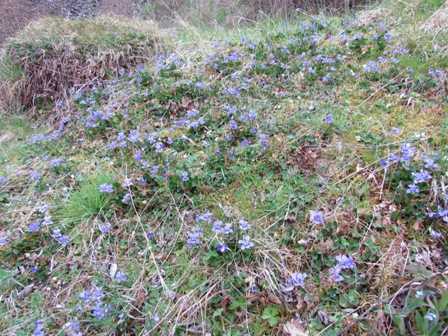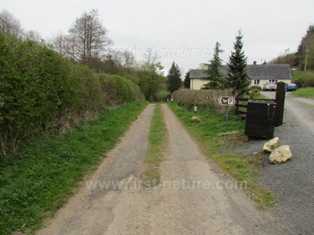Roundton Hill National Nature Reserve, Nr. Newtown, Powys, East Wales
Designations: Part of Roundton Hill SSSI
Below: A Bank of Common Dog Violets Viola riviniana at Roundton Hill

This steep hill of volcanic rock was once topped by a Iron Age Fort which commanded an excellent view of the surrounding countryside. Subsequently mined for lead and other minerals, it is now a nature reserve which protects and preserves the interesting specialised plants that can survive such nutrient-poor conditions.
The site is owned and managed by the Montgomeryshire Wildlife Trust.
Directions
Grid Ref: SO294949
From Newtown, Powys, take the B489 road signed towards Churchstoke.
Once in Churchstoke cross over the bridge and take the first right-hand turn that has a 'brown duck' nature reserve sign. Continue for approximately 1.5km (about a mile) along this narrow lane and then take the second right-hand turn, signed to the nature reserve. Do not take the road to Bishops Castle.
Proceed down the lane to the next nature reserve sign and then bear left down a track leading to the gated entrance of the nature reserve. Once through the gate there is a small ford to negotiate. Continue up the track and bear left into the reserve car park.
Below: The track leading down to Roundton Hill

There are two alternative access points to the reserve, and they can be found via kissing gates off the road that runs on the northern side of Roundton Hill NNR.
Access
This reserve is open throughout the year.
The terrain is uneven and steep in places, and so it is not suitable for wheelchair users or for prams and pushchairs.
Facilities
In the main car park for the reserve there are information boards about the nature reserve, it wildlife and ecology and about the Iron Age Hill Fort, but there are no other facilities. However, in the surrounding villages there are shops as well as pubs and cafés with toilet facilities.
Description of Site
The volcanic rock that underlies Roundton Hill gives rise to its unimproved acid grassland, which is an increasingly rare habitat in the UK. A visit to this NNR, which supports a number of uncommon plants, fungi and birds, is in particular a great opportunity to see some of the specialised plants that depend on this type of habitat for their survival. The reserve is well-known for its populations of 'spring ephemerals': plants which germinate, grow, flower and seed in a period of some four to eight weeks in spring, or until such time as the thin soils on the hill dry out in warmer weather. Notable species are Shepherd's Cress Teesdalia nudicaulis and Upright Chickweed Moenchia erecta.
Although there are small, fragmented areas of unimproved acid grassland throughout Wales, and in Powys in particular, much of what used to be acid grassland of high conservation value is now in poor condition due to overgrazing (and in some instances, under-grazing), the use of agricultural chemicals on the land, woodland planting, quarrying and development.
In spring and early summer the hillside is carpeted with a succession of lovely wildflowers such as the Common Dog Violet Viola riviniana pictured above. Wild Thyme Thymus polytrichus, Tormentil Potentilla erecta, Rock Stonecrop Sedum forsterianum, Lady's Bedstraw Galium verum, Heath Bedstraw Galium saxatile and Sheep's Sorrel Rumex acetosella all take their turns as the seasons progress.
Below: The Date Waxcap, one of the rare fungi that occur in acid grassland.

The rocks also have their share of interesting inhabitants. In the shady overhangs there are communities of lichens and mosses. Apart from being easily damaged or destroyed by some of the treatment listed above, these plants are extremely sensitive to air pollution and so their failure to survive may perhaps be an early warning of problems for us in the longer term.
Even those areas of acid grassland that have suffered from poor management and neglect are still worth a close look late in the summer and early autumn for those most opportunistic of wildlife species - fungi. Unimproved acid grassland sometimes harbours rare and interesting fungi species such as the Date Waxcap Hygrocybe spadicea, Pink Waxcap Porpolomopsis calyptriformis Olive Earthtongue Microglossum olivaceum and Violet Coral Clavaria zollingeri; the latter is also referred to as the Amethyst Fairy Club.
Birds often associated with acid grassland and which you can expect to see at Roundton Hill include Skylarks Alauda arvensis, Green Woodpeckers Picus viridis, Hen Harriers Circus cyaneus and Merlins Falco columbarius.